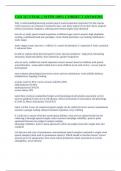CSD 315 FINAL || WITH 100% CORRECT ANSWERS.
Why is understanding/knowing normal speech sound acquisition important? list the reasons
correct answers can compare to normative data, can't know typical if you don't know atypical,
referral assessment, diagnosis, selecting intervention targets, prep dismissal
how do we study speech sound acquisition at different ages correct answers high amplitude
sucking, conditioned head turn paradigm, event related potentials, eye tracking, habituation -
starks stages
starks stages correct answers 1. reflexive 2. control of phonation 3. expansion 4. basic canonical
5. advanced form
be able to explain infant directed speech correct answers motherese - high pitch, fluctuating
intonation, hyperarticulation, short utterences, greater frequencies
why are early, middle late sounds important correct answers based on children with speech
sound disorders - same pattern holds true to most children (even with errors) - can see typical
development
most common phonological processes correct answers substitution, weak syllable deletion,
reduplication, stopping, fronting
severity scale for PCC correct answers mild 85-100%
mild/moderate 65-85%
moderate/severe 50-65%
severe: below 50%
name three common standardized single-word phonological/articulation assessment correct
answers goldman-fristoe test of articulation, clinical assessment of articulation and phonology
(CAAP-2), Photo Articulation Test (PAT)
name 3 of the 4 ways of connected speech sample can be collected correct answers spontaneous
narrative, passage reading, delayed imitation/repetition, story retelling
if a chilician is unsure of his/her transcription abilities, what are two options he/she has for
collecting a thorough speech sample correct answers interjudge reliability: point to point
agreement between two judges (compare sample)
intrajudge reliability: point to point agreement within one judge (transcribe sample later and
compare)
List the pros and cons of spontaneous conversational speech samples compared to single-word
speech samples (often used in spontaneous speech). Which should a clinician choose? correct
answers pro's for spontaneous: hear more natural production, better assessment of overall
inteligibility, more efficient
, cons of spontaneous: might not hear specific productions, less direct, may not know what you're
trying to say --- USE A COMBINATION OF BOTH
three pros and three cons of standardized test correct answers PRO: effiecient and easy method
of obtaining a sample, can compare to standardized data/normalized development stages,
includes all or most speech sound
CON: plays little emphasis on vowels, some children may not recognize a pic/word, child may
be able to imitate but not produce in normal speech
what is an error pattern analysis correct answers assessment on connected speech - do a place
manner voice - think where their problems corss because our phonological patterns also across
place and manner - looking at patterns in typical development or look at analysis to see place
errors manner errors or voicing errors
what is the common atypical phonological process correct answers backing
List three reasons that error analysis is important in phonetic/phonological testing correct
answers -facilitate treatment efficiency
-provide a description of overall phonological system
-may be based on phonological patterns/place/manner/voicing error patterns or both
-pattern identification most important for kids with multiple errors
error pattern analysis types???? correct answers
what are three factors that SLPS should consider when selecting a phonological assessment
correct answers sample obtained, material presentation, scoring and analysis
You are performing an oral mechanism examination. List the preliminary steps you will take to
prepare for the exam (i.e., what tools and supplies will you need?) and at least 4 anatomical
structures that you will assess, and how. Be specific. correct answers flashlight, tongue
depressor, gloves - have child seated at eye level - start at front of oral cavity and progress to
back
-dentition: evaluate the alignment with upper and lower jaws, know the bite, have them say
isolated speech sounds
-hard palate: extend head back, look for discoloration, rub the mucous membrane at midline
-sofe palate: look for coloration (pink or while) examine velar symmetry and elevation
-tongue: evaluate size of tongue in relation to oral cavity, DDK test
case history: why is it important to obtain one? list at lease 3 pieces of information necessary to
gather during a case history correct answers etiological factors, family/child perception of
problem, academic home and social environment information, medical information ---- may
assist clician to form a best guess for what the problem may be and help in selecting specific
tests




